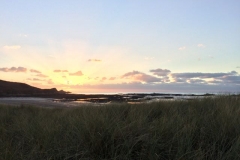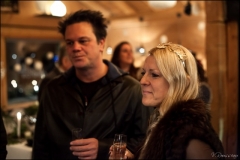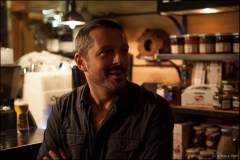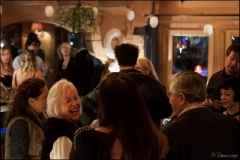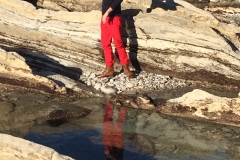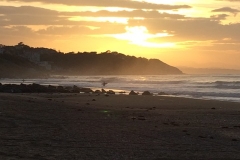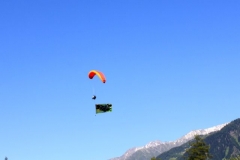My fifth take on the classic French label Saint-James with photographer Emmanuelle Margarita and stylist Céline Merlet – this time going States’-side to give the Big Apple a taste of Breton charm:
Category: General
La Pharmacie des Artistes, Argentière
I have been hosting in this arts and crafts gallery, La Pharmacie des Artistes, in the village of the beautiful and damned since August 2017 – it is so inspirational to have a working gallery space in Argentière, as well as being able to show some of my photographs, with artist Andy Parkin and Rabbit On The Roof Skis.
Saint-James, autumn/winter 2017
My fourth take on the classic French label Saint-James: this time taking the Gallic nautical brand to the Channel Island of Jersey for an ethereal Franco-British feel.
Photographer: Emmanuelle Margarita Stylist: Céline Merlet
New York, baby!
Coors Light #IceCaveRave
I was production manager on this experiential marketing Alpine adventure – spot me mushing my dog sled team! www.hautepursuit.co.uk
Ice Dragons – an environmental fairy tale
 In the corner of Savoisian Gaul that has been endlessly exchanged and argued over throughout history, at the foot of the big White Mount and not far from the Great Lake, a race of dragons slumbers – unlikely to ever reawaken from a near 200 year-long hibernation, as these ice beasts struggle to breathe the millennial polluted air.
In the corner of Savoisian Gaul that has been endlessly exchanged and argued over throughout history, at the foot of the big White Mount and not far from the Great Lake, a race of dragons slumbers – unlikely to ever reawaken from a near 200 year-long hibernation, as these ice beasts struggle to breathe the millennial polluted air.
The five greats: Touraud, Argenteraud, Chamoniard, Bossonard and Tacconard – once all easily visible from the floor of the valley – used to snake down the lengths of the mountainsides and supply the valley people with ice, distilled water and magical caves. If the people became too precocious in their harvesting of the the dragons’ gifts, the ice beasts would calve to drop dangerously heavy séracs from their tips, or belch to send obliterating avalanches down to the settlements on the valley plains.
During the Little Ice Age, the ice dragons were powerfully active and occasionally enraged enough to gobble up whole houses of the villages of Les Bois and La Rosière. But industrial progress broke the weather and subdued the dragons. In the latter part of the 19th century Chamouny and the big White Mount were on the tourist trail, with metallic worms soon to wind their way up the mountainsides, to allow alpine ants to crawl across the dragons’ skins. Progress made the weather warmer and the people more prolific, so the dragons withdrew slowly into themselves and retreated into their long, but fitful sleep.
The last 100 years have seen city elephants join the alpine ants in their exploration of the sleeping ice dragons. In the crucible of developmental progress, environmental forces were smelted to make the prolific peoples evermore controlling and global warming increased with pollution as a side effect. The ice dragons choked on the poisoned air, could not stop themselves melting and shrinking and soon became mere shadows of themselves. Mechanical nazgûl-birds crashed into the slumbering dragons several times, their remains being disgorged some 50 years later. But such incidences did not stop bigger nazgûl-birds bringing hordes of tourists to trample over and throughout the Chamouny Valley and its diminishing giants.
By the new millennial age the dramatic dragonish landscape was over-run with bourgeois grommets, muddy bikers, trail bashers and grim pikeys, in addition to the alpine ants and city elephants. Rock stars, crystal collectors and brave snow scouts endeavoured to control the arrogant crowds, but no one could manage the littering, the consumption, the waste and the insistence on carbon burning by carriages and heaters that fuelled the clouds of pollution that the ice dragons absorbed by osmosis as they slept and shrank.
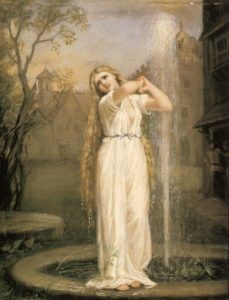 A blonde nereid drifted into the valley, blown off course from the Middle Sea. She soon fell deeply in love with the mountains, the snow and the ice of the slumbering dragons, in particular the Argenteraud, which was weathering the poisonous times slightly better than some of the brothers, his scales still being of blue ice. The nereid developed a complicated relationship with the dragon, encouraged by interactions with snow punks and faeries that she met at a lone stone refuge by the ice dragon’s snout. The snow punks were social malcontents who clung to the old ways to try and preserve their precious environment from the perils of progress. Along with ice jumpers, they supported the rock stars and snow scouts in protecting the ice dragons and encouraged people to respect the mythical beasts. “The ice dragons are much weakened, but are no less fearsome, yet they are the glass lungs of our beautiful valley and planet,” the wise crystal collectors said. “If we continue progressing the way we are, the dragons will shrink and disappear completely and we will all choke in an arid landscape. Before that the snow faeries will no longer be able to clothe the mountains and ice dragons with blankets of snow-flakes and our beloved winter-sports will become pastimes of myth.”
A blonde nereid drifted into the valley, blown off course from the Middle Sea. She soon fell deeply in love with the mountains, the snow and the ice of the slumbering dragons, in particular the Argenteraud, which was weathering the poisonous times slightly better than some of the brothers, his scales still being of blue ice. The nereid developed a complicated relationship with the dragon, encouraged by interactions with snow punks and faeries that she met at a lone stone refuge by the ice dragon’s snout. The snow punks were social malcontents who clung to the old ways to try and preserve their precious environment from the perils of progress. Along with ice jumpers, they supported the rock stars and snow scouts in protecting the ice dragons and encouraged people to respect the mythical beasts. “The ice dragons are much weakened, but are no less fearsome, yet they are the glass lungs of our beautiful valley and planet,” the wise crystal collectors said. “If we continue progressing the way we are, the dragons will shrink and disappear completely and we will all choke in an arid landscape. Before that the snow faeries will no longer be able to clothe the mountains and ice dragons with blankets of snow-flakes and our beloved winter-sports will become pastimes of myth.”
So the little foreign-tongue-speaking nereid vowed to worship and work hard to preserve the enchanting ice dragons, especially her beloved Argenteraud. She called on her friends the sea nymphs of the oceans to help her engage with the oreads of the mountains. This alliance of nymphs and faeries toiled tirelessly with snow tinkers, husky mushers and cowherds to make the tourists, alpine ants and city elephants aware of the ice dragons’ plight and how it would impinge on the comfort of the peoples in the future. They made films with powerful environmental messages; they painted murals depicting strong eco propaganda; they fashioned cool gear from recycled goods; they cast jewellery from imprints of the mountains; they lived off little and wasted nothing. Most importantly, they picked up litter, cleared away rubbish and reminded the peoples how to respect the stunningly beautiful Chamouny valley – their motto was “Save the dragons by protecting our winters.”
It was an uphill battle, however, as the prolific peoples wanted to create more fair-rides and mechanical movements, with increased carriage transportation that required more carbons to be burnt. The valley of Chamouny was morphing into Chamoneyland, an alarming globalist prospect. It seemed the only way to preserve and protect the dragons was by selling them to the prolific peoples as potential entertainment: “We must not let Chamouny turn into a zoo,” the nereid wailed. But an amusement park it was threatening to become. As the dragons dwindled, they revealed a myriad of sparkling crystals under their beds that drew treasure hunters and jewel gawpers to the valley. The scales shed by the the ice dragons became coveted pure blue ice, believed to prevent the natural ageing process of the peoples which saw their harvesting process increase exponentially. As the dragons declined and reduced ever faster, more and more tourists seemed eager to witness their demise, without realising they were watching seriously accelerated global warming.
The nereid felt useless and aggrieved that the campaign to save the ice dragons seemed unable to deliver the right message. “How can I help the ice dragons that are so crucial a part of our mountain existence and how can I save my beloved Argenteraud?” she asked a wise oread who lived in a secluded grotto hidden deep in the silver ore basin at the top of the Chamouny valley. “You have to make the dragons believe that you and the peoples are worth waking up and living for,” the oread advised. “The peoples will never sacrifice anything of their lifestyle to protect and preserve the dragons – they are too consumerist and selfish to do that. But if you stir the ice dragons sufficiently to awaken them completely, you must be prepared for the avalanche activity that could follow.”
 The nereid decided to give herself to Argenteraud, in the hope that she could encourage him to stir his dragon brothers into evolving and surviving, but she needed the help of a snow punk to get that close to and involved with an ice dragon. The snow punks were young masters of the mountains and all very gruff and somewhat dismissive of foreign-tongue-speaking nereids, particularly those who had blown into the valley from the sunny southern seaside. But the nereid couldn’t undertake the quest to wake Argenteraud alone. With much smiling and clever charms, she persuaded a young, down-on-his-luck punk to take her on the long cold journey across the silver ore basin and up to the summit of the Silver Peak, from where they could see Argenteraud in his entirety, stretching and curving along several kilometres. They planned to descend the full height and length of Silver Peak, landing on the ice dragon’s head – squarely between his ears.
The nereid decided to give herself to Argenteraud, in the hope that she could encourage him to stir his dragon brothers into evolving and surviving, but she needed the help of a snow punk to get that close to and involved with an ice dragon. The snow punks were young masters of the mountains and all very gruff and somewhat dismissive of foreign-tongue-speaking nereids, particularly those who had blown into the valley from the sunny southern seaside. But the nereid couldn’t undertake the quest to wake Argenteraud alone. With much smiling and clever charms, she persuaded a young, down-on-his-luck punk to take her on the long cold journey across the silver ore basin and up to the summit of the Silver Peak, from where they could see Argenteraud in his entirety, stretching and curving along several kilometres. They planned to descend the full height and length of Silver Peak, landing on the ice dragon’s head – squarely between his ears.
 The day of expedition dawned and the nereid donned her winter-white ensemble of woven woollens, sheepskin and goose-down, setting off on her wing-tipped and seal-skinned black crows. The tour across the basin was long, but the sun shone brightly to ease the chill of the mountain air. The climb up the Silver Peak was tricky and technical, but the nereid never complained and the snow punk guided her successfully to the summit. After 7 long hours, the pair of eco warriors sat at the top to catch their breath. They could see the whole length of the ice dragon Argenteraud, from his rimaye of a tail hooked on to Mont Dolent, to his snout hanging over the cliff below the lone stone chalet refuge de Lognan. Lower down the valley, past Chamouny town, pollution hung in the air between the mountain ranges like a discoloured mist and the nereid wept to see such beauty tainted by the careless and selfish peoples. The snow punk was touched by her compassion and allowed himself to get past the gruffness and put an arm around the eccentric foreign-tongue-speaking nereid, who was prepared to give so much to save his local habitat.
The day of expedition dawned and the nereid donned her winter-white ensemble of woven woollens, sheepskin and goose-down, setting off on her wing-tipped and seal-skinned black crows. The tour across the basin was long, but the sun shone brightly to ease the chill of the mountain air. The climb up the Silver Peak was tricky and technical, but the nereid never complained and the snow punk guided her successfully to the summit. After 7 long hours, the pair of eco warriors sat at the top to catch their breath. They could see the whole length of the ice dragon Argenteraud, from his rimaye of a tail hooked on to Mont Dolent, to his snout hanging over the cliff below the lone stone chalet refuge de Lognan. Lower down the valley, past Chamouny town, pollution hung in the air between the mountain ranges like a discoloured mist and the nereid wept to see such beauty tainted by the careless and selfish peoples. The snow punk was touched by her compassion and allowed himself to get past the gruffness and put an arm around the eccentric foreign-tongue-speaking nereid, who was prepared to give so much to save his local habitat.
The pair steeled themselves for the steep and long descent to the ice dragon’s head: “What is she going to do once we get there?” the snow punk asking himself. The telemark down the mountain of Silver Peak was on untouched pure powder – the best the snow faeries were known to shower and drift. When they crossed the bergschrund on to the dragon’s back, the surface changed to reveal bands of shiny scaled crevasses and they could feel the slow movement of the dragon breathing. Carefully picking their way across snow bridges and moulins, the duo of mountain punk and sea nymph headed for the ice dragon’s snout. They got to the head just above the lone stone refuge and assessed the torrenting waterfalls flooding from his eyes – he was crying in his sleep. His ears resembled blue labyrinthine caves that the nereid would have to wriggle into, so that she could try and communicate directly with him. She gathered her wits and contorted herself into the dragon’s icy aural cave. Once there, the nereid gently whispered to the ice dragon that she admired and loved him, but that she knew he was dismayed and depleted by the selfish peoples’ pollution of his world. “Wake up, Argenteraud,” she whispered, “and show the peoples your magnitude in the world and role in the environment.”
The ice dragon stirred and his hackles rose, creating sharp blue ice séracs that cracked loudly and rocked the snow punk, who was waiting for the nereid above the crevasse she had crawled into, such that he almost slid off the dragon’s head. “Néréides,” the snow punk called to her in Savoyard patois, “you have woken the ice dragon and now we must leave him to show his might. It is too much for us here – we have to get away!” Deep within the dragon’s aural crevasse the nereid heard the snow punk’s warning, but she knew that the ice dragon would not let both of them go free, so she continued to whisper to Argenteraud, telling him that she loved him unconditionally and was prepared to sacrifice herself to his glacial wrath.
The dragon reared its head and gigantesque séracs broke from his snout, crashing over the cliffs and falling down into the valley, perilously close to the village of the beautiful and the damned below and shaking the lone stone refuge as if in an earthquake. The nereid was ejected from the crevasse as the dragon shook its head, but not to safety, as Argenteraud coughed to set off an almighty avalanche. “Save yourself, Horatio!” the nereid cried to the snow punk, as she was swept past him over the cliff by the icy blast of the avalanche. The snow punk had managed to anchor himself to an icefall away from the dragon before the beast wigged out, so was safer than the nereid but was in agony, as he knew he could not save her. In spite of the snow, ice and rocks avalanching down to the village from the dragon, the snow punk got away in time to stop the nereid disappearing down into a deep chasm in the moraine. But she was frozen solid by the icy blast of dragon’s breath and the nereid resembled a white marble statue.
The snow punk’s heart nearly broke at the demise of the nereid – they had history, which is why he had agreed to accompany her on the quest to wake the ice dragon. He had been somewhat confused by her foreign-tongued love and, indeed, the imp who had bewitched him and then left him, had jealously poisoned the poor nereid by playing an ugly charade of false friendship while the punk was intrigued by the nymph’s smiles. To atone for his charlatanism, the snow punk decided to complete the nereid’s eco campaign, once the glacial wrath of the ice dragon was past.
The immense sérac falls, dramatic avalanche and ensuing earth tremors created by Argenteraud’s stirring made the peoples realise they had to stop being so selfish, respect the ice dragons and let them slumber and gently regenerate. They stopped harvesting the dragon’s ice and fossicking for crystals and precious metals from their beds; they consumed, burned and polluted less; they even swept the dragons’ backs for litter and covered sections that were overly exposed to the sun with space blankets during the summers that followed. The air was cleared and the ice dragons’ retreats were slowed – they could once more sleep in peace.
 Relieved that the nereid’s message had eventually broken through, the snow punk carried her frozen body to the top of the Silver Peak and erected her there as a summit statue, putting her close to the heavens and giving her constant full sight of her beloved ice dragon, Argenteraud. The snow punk insisted that the mountain, he had sat atop of with the nereid during her quest, then be renamed in her honour as Argenteraud’s Needle. And so it was.
Relieved that the nereid’s message had eventually broken through, the snow punk carried her frozen body to the top of the Silver Peak and erected her there as a summit statue, putting her close to the heavens and giving her constant full sight of her beloved ice dragon, Argenteraud. The snow punk insisted that the mountain, he had sat atop of with the nereid during her quest, then be renamed in her honour as Argenteraud’s Needle. And so it was.
Skin Diving At Altitude
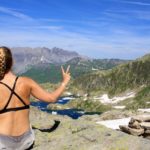
Between the spikes and ridges of the Aiguilles Rouges, the mountain range on the north western side of the Chamonix Valley that faces the Mont-Blanc range, is a plethora of small alpine, once glacial, lakes that link the upper altitudes to the rivers and gorges below in a chain of icy waters. As a committed wild swimmer, who moved to the mountains after five years’ living on the seas, when I clocked these random blue patches, some linked by ribbons of stream trails, on a map of this French national park, I vowed to take to some such lofty waters. I have always loved swimming under the sky and the concept of doing this at over 2000 metres of altitude being all the more appealing, as I would feel that much closer to the heavens.
Not just a wild swimming addict, I also thrive on watery adventures to the point just before being an adrenalin junkie. I’ve dived off sail-boats into four kilometres’ depth of the big blue in both the Pacific and Atlantic Oceans and jumped naked into an Aegean Sea so clear, I could see the sparkling sands of the seabed 20 metres below. Wherever I go in the great outdoors, I carry a bikini (life is always interesting when you’re wearing one) and if I come across a possible swimming spot, then I have to get wet, whatever the weather.
I moved to the Alps of Haute-Savoie because I was chasing a more grounded adventurous lifestyle. The notion of not being on the water was never a concern, as snow, glaciers, waterfalls and lakes are integral elements of the mountain landscape. “Ski every day you can in winter and swim every day you can in summer,” is my active lifestyle mantra. Skin diving at altitude is not for the faint-hearted, however, due to the extreme environment and unpredictable climate – hard hiking for at least an hour or two, being a pre-requisite to the most impressive swimming spots.
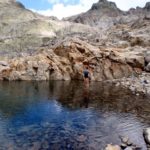
Adhering to the bikini-carrying rule, my first glacial lake dip was somewhat by chance, but actually my highest in terms of altitude. On a high summer hike from the La Flégère cable car, I defied ramblers’ expectations and went for a swim in Upper Lac Noir, situated at some 2495 metres of altitude – my first link in the chain of Aiguilles Rouges alpine lakes. It was July of my first summer in Chamonix and we were striding west along the Grand Balcon Sud, along which there are the Lacs Noirs at 2250m and 2495m, Lac Cornu at 2270m and the Lac du Brévent at 2120m; with the famous Lac Blanc at 2352m and just below that the Lacs des Chésereys from 2157m to 2211m, if you go east. We had gone a tad off-piste from the best-perceived trail, which meant we were doing a fair bit of scrambling on steeps to get through the Col de Glière and it was hot. So by the time Lac Noir Superieur came into view, my heart was racing from exertion and adrenalin, as well as the heat – I couldn’t wait to dive in.

The highest lake of the Aiguilles Rouges is less than 6 metres deep, but that doesn’t make the water temperature balmy, ever. I stripped off my hiking gear and wriggled into my bikini, eyeing the sizeable névé of snow near the water’s edge. In spite of the air temperature and my own body heat, I could not endure a long dip, the iced water taking my breath away. I managed just a few quick strokes and duck-dived under the surface, before racing out to warm up on the granite banks. The feel of bathing in an utterly natural, glacial water pool was extremely bracing, yet stunning. It wasn’t a lengthy alpine swimming experience, but it was certainly refreshing and energising. I felt baptised by a glacier.
Trekking onwards west past the lower Lac Noir d’en Bas and then Lac Cornu, which as more northerly facing still had icebergs of snow in its waters, so I wasn’t tempted to bathe again that time. But I was hooked on the notion of dips at great heights and a summer later, I dived into Lac Blanc – bigger, higher, deeper and colder. Yet still that sensation of swimming in water so pure that you could bottle it, thrilled while it startled.
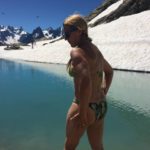
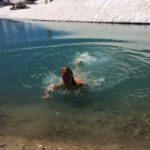
There are a multitude of high mountain lakes in the Aiguilles Rouges, but few are actually swimmable and those that are, require a rare mix of hot, settled weather and the enthusiasm for an energetic journey to reach their purifying waters. Many hikers have bathed in the Chésereys, which are also popular with extreme sports locals as a place for high altitude ‘water-lining’, or slack-lining, across. The Lac du Brévent is less frequented than Lac Blanc, but 20 metres deep and very chilly, even though it is at 220m lower. Lac Vert, west of Le Brévent, is beautiful and easily accessible at only 1270m, but swimming there is just not safe.
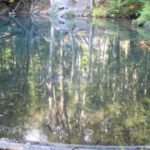
So my greatest delight in wild mountain swimming is finding freshwater pools tucked away among the peaks and troughs that are at lower altitude, clean and safe to swim in. By following a winter snowshoe trail behind the sleepy hamlet of Servoz one summer’s day, I stumbled upon the most divine fairy pool I have found since bathing in geothermal waters in the wilds of Iceland. The Gouille de Pré Guy at 1040m is off the beaten track, not easy to find, crystal clear and briskly fresh. There’s a makeshift forest diving board and a tree swing to prove that local wildlings know about it, although most of those actually go for wild dips in Gouille Noire, which is also somewhat hidden but closer to the village. As I took to these near secret waters, I bathed like an alpine naiad, among the fish, the frogs and the woodland fairies – present in the form of a myriad of butterflies.
BB’s Big Birthday Bash
My birthday banquet at Le Café Comptoir, Vallorcine, December 2016 – party photos by Vivien Rousseau – with seasonal floral designs running wild on the table, as well as the 3 pairs of pictures I decided to show at the event.
Saint-James, autumn/winter 2016
A third take on the classic French label Saint-James: striking out in the edgy location of the Basque Atlantic coast for a cool autumnal look.
Photographer: Emmanuelle Margarita Stylist: Céline Merlet
ChamShake Air’Tistic Festival
My images of the inspiring and active graphic art-in-the-air event in Chamonix Mont-Blanc in hot mid July.
And you can hear all about it (in French) on the fresh airwaves of ChamShake Radio.










